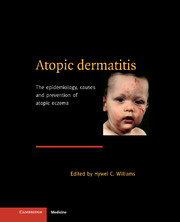Book contents
- Frontmatter
- Contents
- List of contributors
- Foreword Georg Rajka
- Preface
- Part I The nature of the problem
- 1 What is atopic dermatitis and how should it be defined in epidemiological studies?
- 2 The pathophysiology and clinical features of atopic dermatitis
- 3 The natural history of atopic dermatitis
- 4 Occupational aspects of atopic dermatitis
- Part II Descriptive studies which indicate the size of the problem
- Part III Analytical studies which point to causes of atopic dermatitis
- Part IV Intervention studies
- Part V Lessons from other fields of research
- Part VI Conclusions
- Additional information
- Index
- Plate section
2 - The pathophysiology and clinical features of atopic dermatitis
from Part I - The nature of the problem
Published online by Cambridge University Press: 17 August 2009
- Frontmatter
- Contents
- List of contributors
- Foreword Georg Rajka
- Preface
- Part I The nature of the problem
- 1 What is atopic dermatitis and how should it be defined in epidemiological studies?
- 2 The pathophysiology and clinical features of atopic dermatitis
- 3 The natural history of atopic dermatitis
- 4 Occupational aspects of atopic dermatitis
- Part II Descriptive studies which indicate the size of the problem
- Part III Analytical studies which point to causes of atopic dermatitis
- Part IV Intervention studies
- Part V Lessons from other fields of research
- Part VI Conclusions
- Additional information
- Index
- Plate section
Summary
Introduction
Atopic dermatitis (AD) is a common and fascinating inflammatory skin disease, frequently seen in patients with a personal or family history of atopic diseases, including asthma, allergic rhinitis or atopic dermatitis itself. As discussed in Chapter 1, AD is sometimes referred to as atopic eczema or infantile eczema, and here the terms ‘dermatitis’ and ‘eczema’ are used synonymously to describe skin inflammation characterized by erythema and scaling, and sometimes accompanied by vesiculation and crusting. The characteristic feature histologically is epidermal intercellular oedema (spongiosis, spongiotic microvesiculation), and the eruption of AD is usually extremely itchy.
Earlier studies showed the prevalence of AD to be 2% in the United States (Johnson, 1977) and 3% in England (Walker & Warin, 1956), but most recent studies suggest an increased prevalence. Kay et al. (1994) reported a lifetime prevalence of 20% in a UK population and, in a twin study, Schultz Larsen (1993) found a cumulative incidence rate up to seven years of age of 3% for twins born between 1960 and 1964, compared with 12% for those born between 1975 and 1979. Although AD can occur for the first time in adulthood, it begins in the first year of life in about 60% of cases, asthma and allergic rhinitis occurring after infancy (Rajka, 1975).
- Type
- Chapter
- Information
- Atopic DermatitisThe Epidemiology, Causes and Prevention of Atopic Eczema, pp. 25 - 40Publisher: Cambridge University PressPrint publication year: 2000
- 16
- Cited by



